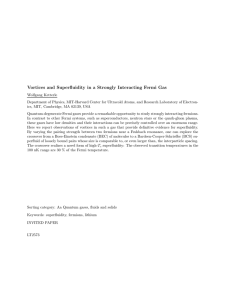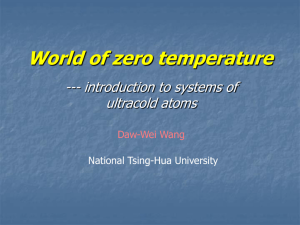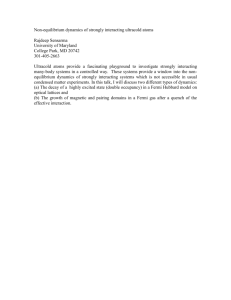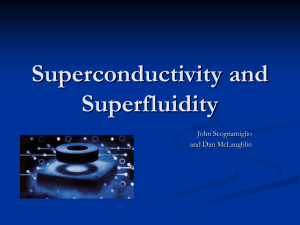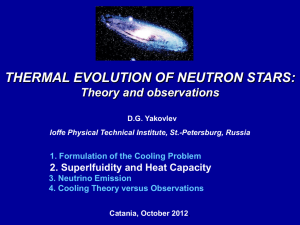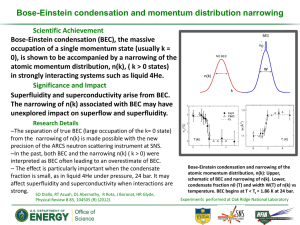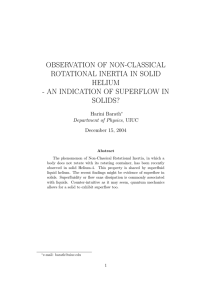What are superconductors?
advertisement
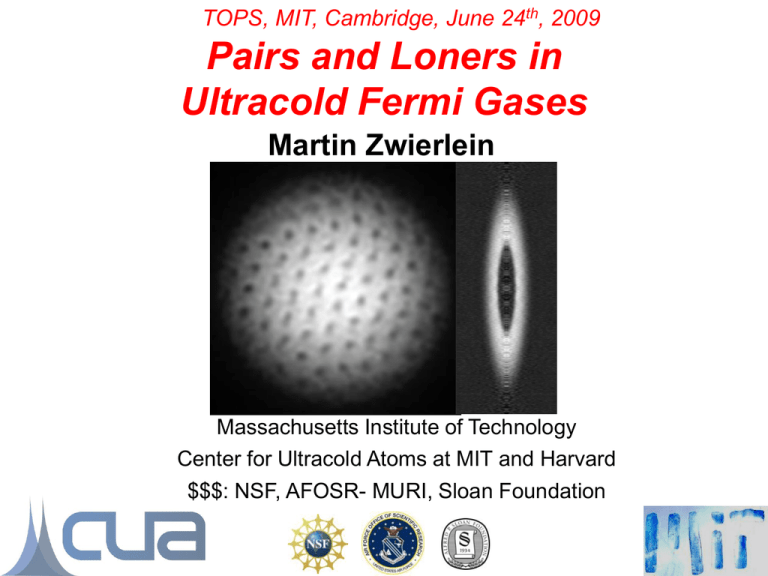
TOPS, MIT, Cambridge, June 24th, 2009 Pairs and Loners in Ultracold Fermi Gases Martin Zwierlein Massachusetts Institute of Technology Center for Ultracold Atoms at MIT and Harvard $$$: NSF, AFOSR- MURI, Sloan Foundation Bosons vs Fermions T TC T TC T 0 EF e.g.: 1H, 23Na, 6Li2 e.g.: e-, 3He, 6Li, 40K Degenerate gases de Broglie wavelength ~ Interparticle spacing n dB n 1/3 n 10 cm 15 Want lifetime > 1s TF 2 kB m n 2/3 1 K 1/3 3 Ultradilute Ultracold Good news: Bosons condense at TC TF How to measure temperature? Gas Effusive atomic beam How to measure temperature? Gas Effusive atomic beam Observation of the atom cloud Trapped Expanded Atom cloud Lens CCD Camera Laser beam Shadow image of the cloud 1 mm BEC @ MIT, 1995 (Sodium) Superfluidity in Bosonic Gases BEC @ JILA, Juni ‘95 (Rubidium) • BEC 1995 All atoms occupy same macroscopic wavefunction MIT • Phase coherence 1997 ENS • Superfluidity 1999/2000 MIT Frictionless flow, BEC @ MIT, Sept. ‘95 (Sodium) quantized vorticity JILA Fermions – The Building Blocks of Matter Lithium-6 Harvard-Smithsonian Center for Astrophysics Can we have superfluidity in a Fermi gas? 1911: Discovery of Superconductors Heike Kamerlingh-Onnes Nobel prize 1913 Resistance • Discovery of Superconductivity in Metals Temperature Superfluids Flow without friction • No energy loss • persistent flow • Doesn’t want to rotate Onnes 1908, Kapitza, Allen & Misener 1938 Superconductors Current without resistance • No energy loss • persistent currents • expels magnetic fields Onnes 1911 Müller & Bednorz 1987 What are superconductors? • Apparently the electrical current flows without friction • But: Carrier of electrical current are Electrons Electrons are Fermions What are superconductors? • Apparently the electrical current flows without friction • But: Carrier of electrical current are Electrons Electrons are Fermions L. Cooper (1956) (45 years after Onnes): Pairing of electrons Pairs are Bosons Superconductivity: Condensation of Electron Pairs J. Bardeen, L. Cooper, R. Schrieffer (BCS), 1957, Nobel prize 1972 Fermionic Superfluidity Condensation of Fermion Pairs Superconductors: Charged superfluids of electron pairs Frictionless flow Resistance-less current John Bardeen Leon N. Cooper John R. Schrieffer High-temperature Superconductors J. Georg Bednorz K. Alex Müller Critical temperature: 35 K above Absolute Zero (-238 °C) Nobel prize 1987 Record today: 138 K (-135 °C) Room temperature superconductors? Today: • ~5-10% energy loss only due to transport of energy The hope: • Superconducting cables • No resistance No energy loss during transport We need: The problem: A model system for superconductors High-temperature superconductivity not really understood Electrons interact so strongly it’s hard to model Ultracold atomicthat gases Can we do this with atoms? YES! The ultracold Fermi gas at MIT: • Lithium-6 (3p, 3n, 3e-) is a fermion • The atoms form pairs like electrons in a superconductor • Size of pairs is freely controllable • The gas becomes superfluid How can you distinguish a superfluid from a normal one? Rotating bucket Normal Fluid Super Fluid Rotating superfluid Superfluid does not want to rotate Only possibility: Vortices, “Mini-Tornados”, “Quantum whirlpools” Superfluids are described by matter wave The wave has to close in itself (Example: Vibrating rubber band) Only full wavelengths are allowed Circulation is only possible in certain units (“Quanta”), carried by the Vortices Look from top into the bucket Look from top into the bucket Aleksei A. Abrikosov Nobel prize 2003 Abrikosov lattice (honeycomb lattice) Vortex lattices in bosonic gases/fluids Berkeley (R.E. Packard, 1979) Helium-4 ENS (J. Dalibard, 2000) Rubidium BEC Rotation of a neutral Fluid F 2mv Coriolis Force Superconductor in a magnetic field F qv B Lorentz Force U. Essmann and H. Träuble, Physics Letters A, 24, 526 (1967) Demonstration of superfluidity in a Fermi gas Ultracold gas Vortex lattices • Demonstration of superfluidity in a gas of atom pairs • A high-temperature superfluid - 0.7 Pair size B Scaled to the density of electrons in a metal, the gas M.W. Zwierlein, J.R. Abo-Shaeer, A. Schirotzek, C.H. Schunck, W. Ketterle, would become superfluid far aboveNature room435, temperature 1047-1051 (2005) Fermionic Superfluidity with Imbalanced Spin Populations What if there are too many singles? Fermionic Superfluidity with Imbalanced Spin Populations |1> |2> 0% 6% 12% 22% 30% 56% 90% 94% What is the Nature of the Imbalanced State? Direct observation of the density difference Cooling Down Normal Superfluid Y. Shin, M.W. Zwierlein, C.H. Schunck, A. Schirotzek, W. Ketterle, PRL 97, 030401 (2006) Reconstruction of 3D density profile d = 0.6 Only assumption: cylindrical symmetry Phase Separation ! Fermionic Superfluidity does not tolerate loners Gallery of superfluid Gases Atomic Bose-Einstein Condensates (Sodium) Molecular Bose-Einstein Condensates (6Li2) Pairs of fermionic atoms (6Li) Ultracold Atoms As Model systems: • How does matter work? new quantum states, development of new materials Quantum computer, Quantum simulators (Bose and Fermi gases) As measuring device: • Development of highly sensitive sensors gravitational gradient sensors (important for mining, geophysics), sensors for navigation • New highly accurate atomic clocks as time standard basis of all GPS-systems, more accurate positioning, faster telecommunication requires accurate clocks The team BEC 1: Andre Schirotzek Ariel Sommer Fermi 1: Cheng-Hsun Wu Ibon Santiago Dr. Peyman Ahmadi Undergraduates: Caroline Figgatt Jacob Sharpe Sara Campbell Kevin Fischer 39K 40K 6Li
